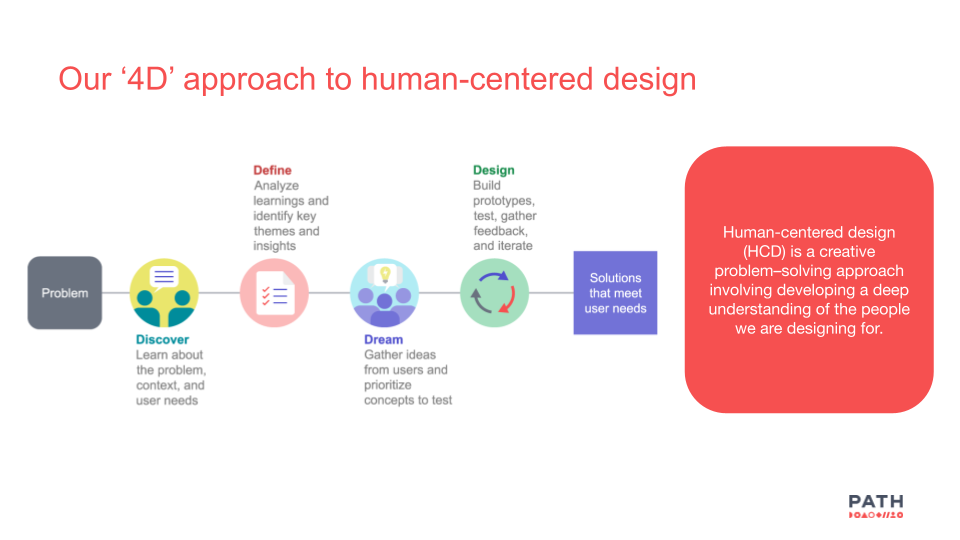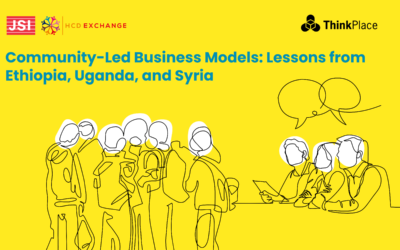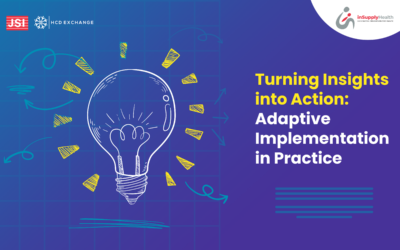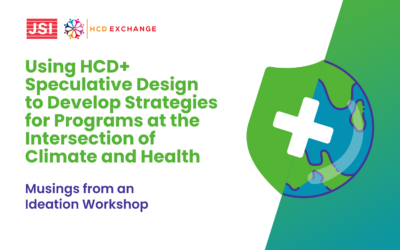As we continue to explore HCD insights as a thematic area at the HCDExchange, our second event in the event series ‘Power of HCD insights’ explored the process of turning insights into powerful solutions. The purpose of this session was to share knowledge and tools that practitioners can use in their work to move from an insight statement to a concept for a solution.
We hosted the second webinar on May 29, 2024, in partnership with PATH’s Living Labs. The team took the audience through their project on ‘Co-creating solutions to increase demand for HPV Vaccine’ to highlight the process they used to move from insights to actionable statements that enable solutions thinking, and finally to co-creating solution concepts with their users.
Below is a summary of what was covered:
Living Labs’ 4D approach to human-centered design
Living Labs employs the human-centered design (HCD) process to accelerate access to and utilization of health products and interventions by rapidly co-creating, testing, and refining solutions with users. Through observing, empathizing, and learning directly from the user, they co-create solutions that are more acceptable, usable, and sustainable.
The HCD process that the Living Labs team used has 4 key phases – Discover, Define, Dream, and Design.

|
Insights From a Super-User Florence Aketch is a Chief Nursing Officer in Kisumu County and a part of the User Advisory Group at PATH Living Labs. One of the high points in Florence’s work with PATH Living Labs was addressing the low uptake of the Measles Rubella 2 and HPV vaccines among girls aged 10 to 14. Using Human-Centered Design (HCD), Florence and the PATH Living Labs team engaged teachers, pupils, caregivers, and healthcare workers through focus group discussions, interviews, and interactive sessions. These interactions helped identify the challenges preventing girls from getting vaccinated and facilitated the co-creation of solutions. One particular initiative stands out for Florence – HATA (HPV advocacy through art). This was tested in Kisumu. The aim was to raise awareness and sensitize pupils and teachers about HPV vaccination using art to make the information more engaging. This involved collaborating with the county director of education to gain access to schools across three sub-counties: urban, peri-urban, and rural. Each sub-county selected two schools, one as a control site and the other as an implementing site. Through the headteachers, the team connected with school health teachers who organized two sensitization days, one for teachers and another for pupils. Following these sessions, a vaccination date was set within a week. Teachers were also guided to organize an essay writing activity for students from class 4 to class 8, with the top three essays selected as winners. This initiative resulted in a 100% vaccination uptake in the implementation sites and a 30% uptake in the comparative sites. |
The Define Phase
In the 4D design process, the “Define” phase shapes the direction of the intervention or solution that will be co-created with the users. It is important to engage users early in this phase because when this is not done, problems are framed from a distance and that leads to solutions that fail when implemented as they address the wrong issues.
In the define phase, after sorting through data to identify key patterns and themes, findings are synthesized into insights. This important point is the bridge to the phase where solutions are conceptualized. This bridge serves as a crucial link between research and solution design and the success of a project. Insights need to be presented clearly and unpacked so that they are effectively applied to the design process. This involves translating insights into design principles, facilitating discussions among stakeholders, and guiding the co-creation of meaningful and actionable solutions. This step not only helps advance the project but also ensures that the solutions developed are deeply rooted in well-understood user needs and contexts.
Insights Explorer Tool: The PATH Living Labs team developed this tool as a way to document their insights for use by other actors in the public health field – partners, government, etc. The tool is a catalog of demotivating factors and a playbook of solutions that was co-created for one of their projects.
Point Of View (POV) Statements: The POV statement is a powerful way to develop empathy with one’s users as it highlights who they are, their needs and their motivations. This framework allows one to remain as human centered as possible, articulating user’s perspectives and emotional experiences.
Example of a POV statement:
“A young, bored and demoralized health care worker needs a way of breaking up his daily monotonous immunization routine ,that makes him lose interest in giving quality services.”
How Might We (HMW) Questions: How Might We’s (HMW) are questions that help frame the problem for ideation. They help in moving away from the convergent thinking in defining the POV statements to opening up a space to think ‘without the box’, which supports creativity and allows divergent thinking. These questions are used in brainstorming solutions while ensuring that one is sticking to solving well-defined problems. HMWs are derived from the POV statements and should be broad enough to allow for creative ideas but confined within the insights identified from the POV. When creating an HMW question from a POV statement one should avoid suggesting a solution in the HMW question, but instead focus on the desired outcome and phrase it positively.
HMW Statements follows the format: How Might We [intended experience] for [user] so that [desired goal/effect]
Design Principles: Design principles are clear instructive guardrails for what one can consider while designing the final solution. These guardrails are themselves informed by insights from research.
|
Increase Demand for the HPV Vaccine In this project the PATH Living Labs team understood the determinants of HPV vaccine demand and co-created solutions to increase uptake. They spoke to multiple stakeholders and found that the communities have limited knowledge about HPV and the HPV vaccine resulting in their vaccine hesitancy. After the research, the team developed insights from the raw data. Through these insights, they discovered underlying motivations that drive different stakeholders actions. POV Statement: All the community members, especially caregivers (CGs) and their daughters need to be fully sensitized on the benefits of the vaccine, the possible side effects, and any other concerns such as why it is girls being vaccinated and the eligible age, because they are the main enablers and/or inhibitors of uptake depending on the level of accurate information they have. HMW statement: HMW ensure that CGs and their daughters are well-informed about the HPV vaccine and its effectiveness against cervical cancer? |
The Dream Phase
In the dream phase, one gathers ideas and input from users/ stakeholders based on the insights generated. The design team further engages stakeholders in finding solutions/ideas (dreaming) for a defined design challenge through a series of activities.
Validation Workshop: For the PATH Living Labs team, the Dream phase begins with a Validation Workshop. In this phase, stakeholders and users previously engaged during the research are invited back, which helps to build on the established rapport. To promote equity, the composition of invited stakeholders is diverse, including both caregivers and healthcare workers (HCWs), and consideration is given to gender representation by inviting both male and female caregivers. This helps in bringing in unheard voices within the community, enabling them to influence decision-making processes.
The workshop starts with designers presenting insights back to the stakeholders for validation. The initial discussion confirms the accuracy of the information captured, as stakeholders verify the insights and help identify any inaccuracies. Following this, the team introduces the design challenge by sharing the point-of-view (POV) statement and posing the “How might we” (HMW) question.
Co-creation session: The co-creation session is aimed at guiding the diverse set of stakeholders to brainstorm and come up with concepts for solutions that are informed by the insights and HMWs. Below is a set of tools that the PATH Living Labs team uses to achieve this objective:
- Brainstorming with the Crazy eights: In response to a HMW question and highlighted challenges, users are asked to write 8 ideas/solutions. For each challenge, each user writes 8 solutions in 8 minutes. This is one of the ways through which PATH Living Labs promotes health equity by raising silent voices. The tool results in a list of ideas that will later be prioritized by the group of users.
- Sorting and Grouping similar ideas with the Impact vs Effort matrix: Depending on the prioritization needs, designers ask users to sort the ideas in an impact vs. effort matrix and then prioritize an idea/s in the high impact, low effort quadrant. The prioritization matrix helps designers and users to identify low-hanging fruits. These are solutions that will have the highest impact in solving the design challenge and at the same time do not need a lot of effort in terms of time and resources.
- Prioritize ideas with the Dot-mocracy – Dot voting tool: This tool helps with the prioritization of ideas by enabling users and stakeholders to vote for the ideas that they consider most important. Each idea is displayed, for users and stakeholders to choose from by placing or drawing dots on the ideas they wish to prioritize. Depending on prioritization needs, a user may have one or multiple opportunities to vote. This method ensures that all participants can actively engage in selecting any ideas that they believe should be taken forward.
- Concept Creation with the Lean concept sheet: This tool helps in fleshing out raw ideas into a format that expands the idea further. These details help in drawing out things that influenced the creation of the idea and highlight what is required to create a prototype of the concept/idea.
About Path Living Labs
PATH’s Living Labs Initiative accelerates the pace of health innovation by co-creating with users to rapidly design, test, and scale solutions to their long-standing challenges. With a multidisciplinary team of product engineers, health systems design professionals, material designers, behavioral scientists, clinicians, quantitative modelers, and market access specialists, the Living Labs uses a mixed-methods approach to create sustainable, impactful health solutions across several health areas and program teams. They do this by 1) Prioritizing listening and empowering users, 2) Using our in-country design experts who understand the local health care system, and 3) Rapid ideation, prototyping, and iterative testing.



